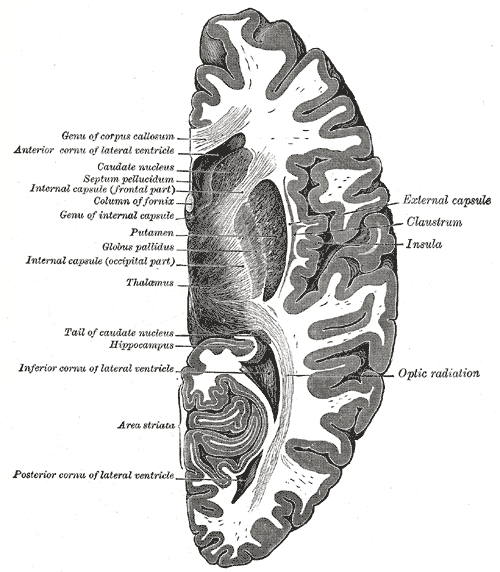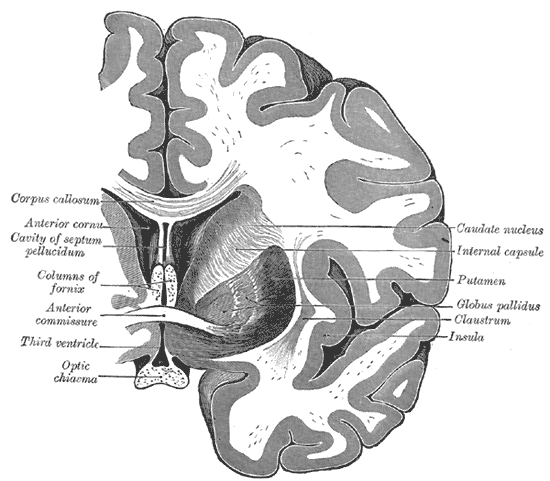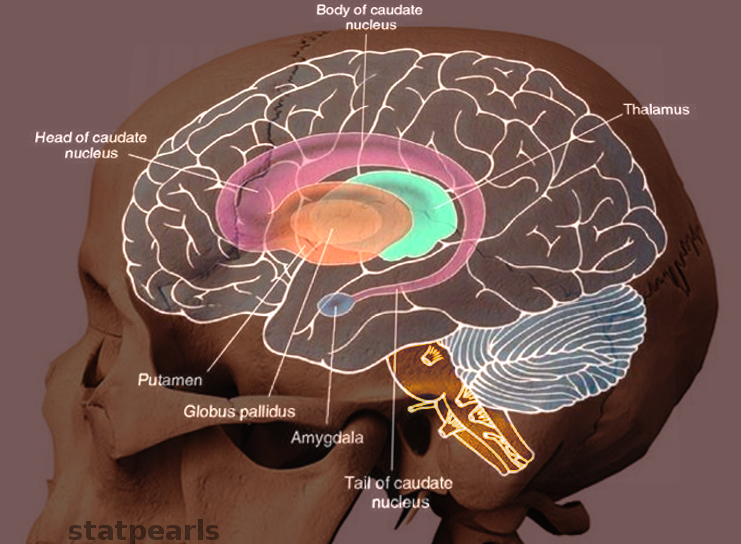[2]
Viñas-Guasch N,Wu YJ, The role of the putamen in language: a meta-analytic connectivity modeling study. Brain structure
[PubMed PMID: 28585051]
[3]
Koikkalainen J,Hirvonen J,Nyman M,Lötjönen J,Hietala J,Ruotsalainen U, Shape variability of the human striatum--Effects of age and gender. NeuroImage. 2007 Jan 1;
[PubMed PMID: 17056276]
[4]
Parent A,Hazrati LN, Functional anatomy of the basal ganglia. I. The cortico-basal ganglia-thalamo-cortical loop. Brain research. Brain research reviews. 1995 Jan;
[PubMed PMID: 7711769]
[5]
Haber SN, The primate basal ganglia: parallel and integrative networks. Journal of chemical neuroanatomy. 2003 Dec;
[PubMed PMID: 14729134]
[6]
Alexander GE,DeLong MR,Strick PL, Parallel organization of functionally segregated circuits linking basal ganglia and cortex. Annual review of neuroscience. 1986;
[PubMed PMID: 3085570]
[7]
Fazl A,Fleisher J, Anatomy, Physiology, and Clinical Syndromes of the Basal Ganglia: A Brief Review. Seminars in pediatric neurology. 2018 Apr;
[PubMed PMID: 29735113]
[8]
Uono S,Sato W,Kochiyama T,Kubota Y,Sawada R,Yoshimura S,Toichi M, Putamen Volume is Negatively Correlated with the Ability to Recognize Fearful Facial Expressions. Brain topography. 2017 Nov;
[PubMed PMID: 28748407]
[9]
Starr CJ,Sawaki L,Wittenberg GF,Burdette JH,Oshiro Y,Quevedo AS,McHaffie JG,Coghill RC, The contribution of the putamen to sensory aspects of pain: insights from structural connectivity and brain lesions. Brain : a journal of neurology. 2011 Jul
[PubMed PMID: 21616963]
[10]
Mortazavi MM,Adeeb N,Griessenauer CJ,Sheikh H,Shahidi S,Tubbs RI,Tubbs RS, The ventricular system of the brain: a comprehensive review of its history, anatomy, histology, embryology, and surgical considerations. Child's nervous system : ChNS : official journal of the International Society for Pediatric Neurosurgery. 2014 Jan;
[PubMed PMID: 24240520]
[11]
Djulejić V,Marinković S,Georgievski B,Stijak L,Aksić M,Puškaš L,Milić I, Clinical significance of blood supply to the internal capsule and basal ganglia. Journal of clinical neuroscience : official journal of the Neurosurgical Society of Australasia. 2016 Mar;
[PubMed PMID: 26596401]
[12]
Sun BL,Wang LH,Yang T,Sun JY,Mao LL,Yang MF,Yuan H,Colvin RA,Yang XY, Lymphatic drainage system of the brain: A novel target for intervention of neurological diseases. Progress in neurobiology. 2018 Apr - May;
[PubMed PMID: 28903061]
[13]
Laman JD,Weller RO, Editorial: route by which monocytes leave the brain is revealed. Journal of leukocyte biology. 2012 Jul;
[PubMed PMID: 22745459]
Level 3 (low-level) evidence
[14]
Engelhardt B,Carare RO,Bechmann I,Flügel A,Laman JD,Weller RO, Vascular, glial, and lymphatic immune gateways of the central nervous system. Acta neuropathologica. 2016 Sep;
[PubMed PMID: 27522506]
[15]
Aldea R,Weller RO,Wilcock DM,Carare RO,Richardson G, Cerebrovascular Smooth Muscle Cells as the Drivers of Intramural Periarterial Drainage of the Brain. Frontiers in aging neuroscience. 2019;
[PubMed PMID: 30740048]
[16]
Iliff JJ,Wang M,Liao Y,Plogg BA,Peng W,Gundersen GA,Benveniste H,Vates GE,Deane R,Goldman SA,Nagelhus EA,Nedergaard M, A paravascular pathway facilitates CSF flow through the brain parenchyma and the clearance of interstitial solutes, including amyloid β. Science translational medicine. 2012 Aug 15;
[PubMed PMID: 22896675]
[17]
Aspelund A,Antila S,Proulx ST,Karlsen TV,Karaman S,Detmar M,Wiig H,Alitalo K, A dural lymphatic vascular system that drains brain interstitial fluid and macromolecules. The Journal of experimental medicine. 2015 Jun 29;
[PubMed PMID: 26077718]
[18]
Bradley WG Jr, CSF Flow in the Brain in the Context of Normal Pressure Hydrocephalus. AJNR. American journal of neuroradiology. 2015 May;
[PubMed PMID: 25355813]
[19]
Johanson CE,Duncan JA 3rd,Klinge PM,Brinker T,Stopa EG,Silverberg GD, Multiplicity of cerebrospinal fluid functions: New challenges in health and disease. Cerebrospinal fluid research. 2008 May 14;
[PubMed PMID: 18479516]
[20]
Hladky SB,Barrand MA, Mechanisms of fluid movement into, through and out of the brain: evaluation of the evidence. Fluids and barriers of the CNS. 2014;
[PubMed PMID: 25678956]
[21]
Pollock H,Hutchings M,Weller RO,Zhang ET, Perivascular spaces in the basal ganglia of the human brain: their relationship to lacunes. Journal of anatomy. 1997 Oct;
[PubMed PMID: 9418990]
[22]
Halkur Shankar S,Ballal S,Shubha R, Study of normal volumetric variation in the putamen with age and sex using magnetic resonance imaging. Clinical anatomy (New York, N.Y.). 2017 May;
[PubMed PMID: 28281277]
[23]
Ahsan RL,Allom R,Gousias IS,Habib H,Turkheimer FE,Free S,Lemieux L,Myers R,Duncan JS,Brooks DJ,Koepp MJ,Hammers A, Volumes, spatial extents and a probabilistic atlas of the human basal ganglia and thalamus. NeuroImage. 2007 Nov 1;
[PubMed PMID: 17851093]
[25]
Hsieh PC,Cho DY,Lee WY,Chen JT, Endoscopic evacuation of putaminal hemorrhage: how to improve the efficiency of hematoma evacuation. Surgical neurology. 2005 Aug;
[PubMed PMID: 16051009]
[26]
Munakomi S,Agrawal A, Advancements in Managing Intracerebral Hemorrhage: Transition from Nihilism to Optimism. Advances in experimental medicine and biology. 2019 Mar 20
[PubMed PMID: 30888664]
Level 3 (low-level) evidence
[27]
Suyama D,Kumar B,Watanabe S,Tanaka R,Yamada Y,Kawase T,Kato Y, Endoscopic Approach to Putaminal Bleed. Asian journal of neurosurgery. 2019 Jan-Mar;
[PubMed PMID: 30937010]
[28]
Chen CC,Cho DY,Chang CS,Chen JT,Lee WY,Lee HC, A stainless steel sheath for endoscopic surgery and its application in surgical evacuation of putaminal haemorrhage. Journal of clinical neuroscience : official journal of the Neurosurgical Society of Australasia. 2005 Nov;
[PubMed PMID: 16275100]
[29]
Suyama D,Kumar B,Watanabe S,Tanaka R,Yamada Y,Kawase T,Kato Y, Endoscopic Approach to Cerebellar and Large Putaminal Bleed. Asian journal of neurosurgery. 2019 Jan-Mar;
[PubMed PMID: 30937012]
[31]
Sato S,Koga M,Yamagami H,Okuda S,Okada Y,Kimura K,Shiokawa Y,Nakagawara J,Furui E,Hasegawa Y,Kario K,Arihiro S,Nagatsuka K,Minematsu K,Toyoda K, Conjugate eye deviation in acute intracerebral hemorrhage: stroke acute management with urgent risk-factor assessment and improvement--ICH (SAMURAI-ICH) study. Stroke. 2012 Nov
[PubMed PMID: 22984006]
[32]
DelBello MP,Zimmerman ME,Mills NP,Getz GE,Strakowski SM, Magnetic resonance imaging analysis of amygdala and other subcortical brain regions in adolescents with bipolar disorder. Bipolar disorders. 2004 Feb;
[PubMed PMID: 14996140]
[33]
Roessner V,Overlack S,Schmidt-Samoa C,Baudewig J,Dechent P,Rothenberger A,Helms G, Increased putamen and callosal motor subregion in treatment-naïve boys with Tourette syndrome indicates changes in the bihemispheric motor network. Journal of child psychology and psychiatry, and allied disciplines. 2011 Mar;
[PubMed PMID: 20883521]
[34]
Xu B,Jia T,Macare C,Banaschewski T,Bokde ALW,Bromberg U,Büchel C,Cattrell A,Conrod PJ,Flor H,Frouin V,Gallinat J,Garavan H,Gowland P,Heinz A,Ittermann B,Martinot JL,Paillère Martinot ML,Nees F,Orfanos DP,Paus T,Poustka L,Smolka MN,Walter H,Whelan R,Schumann G,Desrivières S, Impact of a Common Genetic Variation Associated With Putamen Volume on Neural Mechanisms of Attention-Deficit/Hyperactivity Disorder. Journal of the American Academy of Child and Adolescent Psychiatry. 2017 May;
[PubMed PMID: 28433093]
[35]
Sachs-Ericsson NJ,Hajcak G,Sheffler JL,Stanley IH,Selby EA,Potter GG,Steffens DC, Putamen Volume Differences Among Older Adults: Depression Status, Melancholia, and Age. Journal of geriatric psychiatry and neurology. 2018 Jan;
[PubMed PMID: 29251178]
[36]
Campbell LE,Daly E,Toal F,Stevens A,Azuma R,Karmiloff-Smith A,Murphy DG,Murphy KC, Brain structural differences associated with the behavioural phenotype in children with Williams syndrome. Brain research. 2009 Mar 3;
[PubMed PMID: 19118537]
[37]
Zou L,Song Y,Zhou X,Chu J,Tang X, Regional morphometric abnormalities and clinical relevance in Wilson's disease. Movement disorders : official journal of the Movement Disorder Society. 2019 Apr;
[PubMed PMID: 30817852]
[38]
Cheung C,Yu K,Fung G,Leung M,Wong C,Li Q,Sham P,Chua S,McAlonan G, Autistic disorders and schizophrenia: related or remote? An anatomical likelihood estimation. PloS one. 2010 Aug 18;
[PubMed PMID: 20805880]
[39]
Jollant F,Wagner G,Richard-Devantoy S,Köhler S,Bär KJ,Turecki G,Pereira F, Neuroimaging-informed phenotypes of suicidal behavior: a family history of suicide and the use of a violent suicidal means. Translational psychiatry. 2018 Jun 19;
[PubMed PMID: 29921964]
[40]
de Wit SJ,Alonso P,Schweren L,Mataix-Cols D,Lochner C,Menchón JM,Stein DJ,Fouche JP,Soriano-Mas C,Sato JR,Hoexter MQ,Denys D,Nakamae T,Nishida S,Kwon JS,Jang JH,Busatto GF,Cardoner N,Cath DC,Fukui K,Jung WH,Kim SN,Miguel EC,Narumoto J,Phillips ML,Pujol J,Remijnse PL,Sakai Y,Shin NY,Yamada K,Veltman DJ,van den Heuvel OA, Multicenter voxel-based morphometry mega-analysis of structural brain scans in obsessive-compulsive disorder. The American journal of psychiatry. 2014 Mar;
[PubMed PMID: 24220667]
[41]
Figee M,Wielaard I,Mazaheri A,Denys D, Neurosurgical targets for compulsivity: what can we learn from acquired brain lesions? Neuroscience and biobehavioral reviews. 2013 Mar;
[PubMed PMID: 23313647]
[43]
Yang JH,Lee HD,Kwak SY,Byun KH,Park SH,Yang D, Mechanism of cognitive impairment in chronic patients with putaminal hemorrhage: A diffusion tensor tractography. Medicine. 2018 Jul;
[PubMed PMID: 30024496]
[44]
Bhatia R,Kumar M,Garg A,Nanda A, Putaminal necrosis due to methanol toxicity. Practical neurology. 2008 Dec;
[PubMed PMID: 19015300]
[45]
Burgaleta M,Sanjuán A,Ventura-Campos N,Sebastian-Galles N,Ávila C, Bilingualism at the core of the brain. Structural differences between bilinguals and monolinguals revealed by subcortical shape analysis. NeuroImage. 2016 Jan 15;
[PubMed PMID: 26505300]
[46]
Noriuchi M,Kikuchi Y,Senoo A, The functional neuroanatomy of maternal love: mother's response to infant's attachment behaviors. Biological psychiatry. 2008 Feb 15;
[PubMed PMID: 17686467]



